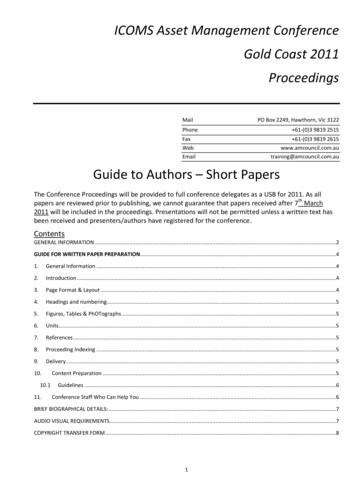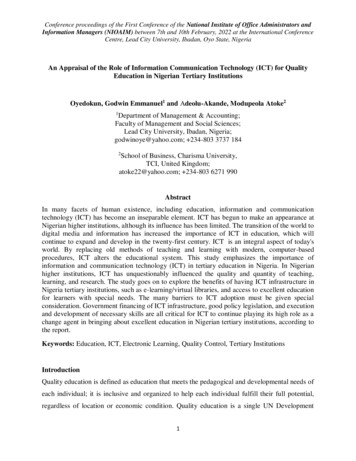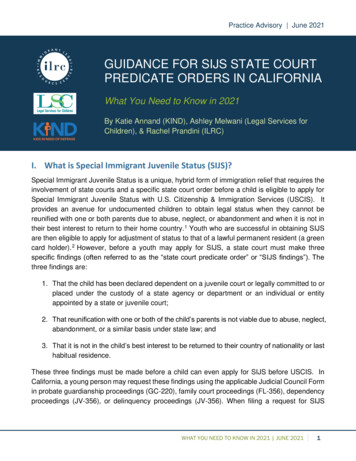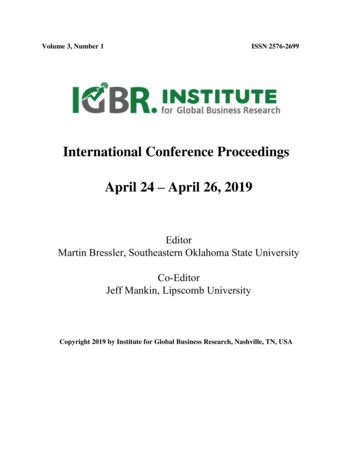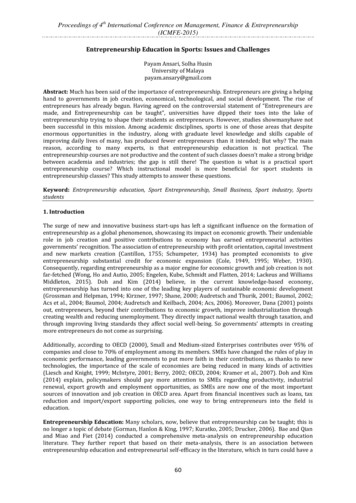
Transcription
Proceedings of 4th International Conference on Management, Finance & Entrepreneurship(ICMFE-2015)Entrepreneurship Education in Sports: Issues and ChallengesPayam Ansari, Solha HusinUniversity of Malayapayam.ansary@gmail.comAbstract: Much has been said of the importance of entrepreneurship. Entrepreneurs are giving a helpinghand to governments in job creation, economical, technological, and social development. The rise ofentrepreneurs has already begun. Having agreed on the controversial statement of “Entrepreneurs aremade, and Entrepreneurship can be taught”, universities have dipped their toes into the lake ofentrepreneurship trying to shape their students as entrepreneurs. However, studies showmanyhave notbeen successful in this mission. Among academic disciplines, sports is one of those areas that despiteenormous opportunities in the industry, along with graduate level knowledge and skills capable ofimproving daily lives of many, has produced fewer entrepreneurs than it intended; But why? The mainreason, according to many experts, is that entrepreneurship education is not practical. Theentrepreneurship courses are not productive and the content of such classes doesn’t make a strong bridgebetween academia and industries; the gap is still there! The question is what is a practical sportentrepreneurship course? Which instructional model is more beneficial for sport students inentrepreneurship classes? This study attempts to answer these questions.Keyword: Entrepreneurship education, Sport Entrepreneurship, Small Business, Sport industry, Sportsstudents1. IntroductionThe surge of new and innovative business start-ups has left a significant influence on the formation ofentrepreneurship as a global phenomenon, showcasing its impact on economic growth. Their undeniablerole in job creation and positive contributions to economy has earned entrepreneurial activitiesgovernments’ recognition. The association of entrepreneurship with profit orientation, capital investmentand new markets creation (Cantillon, 1755; Schumpeter, 1934) has prompted economists to giveentrepreneurship substantial credit for economic expansion (Cole, 1949, 1995; Weber, 1930).Consequently, regarding entrepreneurship as a major engine for economic growth and job creation is notfar-fetched (Wong, Ho and Autio, 2005; Engelen, Kube, Schmidt and Flatten, 2014; Lackeus and WilliamsMiddleton, 2015). Doh and Kim (2014) believe, in the current knowledge-based economy,entrepreneurship has turned into one of the leading key players of sustainable economic development(Grossman and Helpman, 1994; Kirzner, 1997; Shane, 2000; Audretsch and Thurik, 2001; Baumol, 2002;Acs et al., 2004; Baumol, 2004; Audretsch and Keilbach, 2004; Acs, 2006). Moreover, Dana (2001) pointsout, entrepreneurs, beyond their contributions to economic growth, improve industrialization throughcreating wealth and reducing unemployment. They directly impact national wealth through taxation, andthrough improving living standards they affect social well-being. So governments’ attempts in creatingmore entrepreneurs do not come as surprising.Additionally, according to OECD (2000), Small and Medium-sized Enterprises contributes over 95% ofcompanies and close to 70% of employment among its members. SMEs have changed the rules of play ineconomic performance, leading governments to put more faith in their contributions, as thanks to newtechnologies, the importance of the scale of economies are being reduced in many kinds of activities(Liesch and Knight, 1999; McIntyre, 2001; Berry, 2002; OECD, 2004; Kramer et al., 2007). Doh and Kim(2014) explain, policymakers should pay more attention to SMEs regarding productivity, industrialrenewal, export growth and employment opportunities, as SMEs are now one of the most importantsources of innovation and job creation in OECD area. Apart from financial incentives such as loans, taxreduction and import/export supporting policies, one way to bring entrepreneurs into the field iseducation.Entrepreneurship Education: Many scholars, now, believe that entrepreneurship can be taught; this isno longer a topic of debate (Gorman, Hanlon & King, 1997; Kuratko, 2005; Drucker, 2006). Bae and Qianand Miao and Fiet (2014) conducted a comprehensive meta-analysis on entrepreneurship educationliterature. They further report that based on their meta-analysis, there is an association betweenentrepreneurship education and entrepreneurial self-efficacy in the literature, which in turn could have a60
Proceedings of 4th International Conference on Management, Finance & Entrepreneurship(ICMFE-2015)role in enhancing entrepreneurial intentions (Wilson, Kickul, &Marlino, 2007; Zhao, Seibert, & Hills,2005). In examining the literature, it appears that entrepreneurial self-efficacy is perceived to be thebelief in one’s ability to undertake and execute various entrepreneurial tasks and roles with success(Chen et al., 1998; De Noble, Jung & Ehrlich, 1999; McGee, Peterson, Mueller &Sequeira, 2009) and isconsidered to be one of the triggers of entrepreneurial intentions (Chen et al.; De Noble et al.; Douglas,2013; Fitzsimmons & Douglas, 2011; Krueger et al., 2000; Scott &Twomey, 1988; Segal, Schoenfeld, &Borgia, 2007; Wang, Wong, & Lu, 2002). Moreover, Education has been identified as one of the keycharacteristics of entrepreneurship (Shane, 2000; Suddaby et al., 2015).Having agreed on thecontroversial statement of “Entrepreneurs are made, and Entrepreneurship can be taught”, universitieshave dipped their toes into the lake of entrepreneurship trying to shape their students as entrepreneurs.Entrepreneurship education is defined by The Centre for Entrepreneurial Leadership Clearinghouse onEntrepreneurship (refer to www.celcee.edu) as the process in which an individual receives theknowledge and skills required for opportunity discovery, and the insight and capability to act andimplement what is necessary to pursue that discovered opportunity which was overlooked by others. Thedefinition of entrepreneurial education given by GEM 2012 Global Report (Xavier et al., 2012, p.35) is:“The extent to which training in creating/managing new, small or growing business entities isincorporated within the education and training system at all levels”. However, Fayolle et al. (2006)explain, entrepreneurship education programs (EEP) are defined from various aspects, mainly aspedagogical courses that aim to increase entrepreneurial knowledge, skills and attitude and alsodevelopment of certain personal qualities. Therefore, producing entrepreneurs might not be the mainobjective of an entrepreneurship education program. Although the EEP literature is growing, however theempirical evidence that support its effect on new businesses and entrepreneurial activities is stillinsignificant (Cox et al., 2002; Matlay, 2008). Scholars (Peterman and Kennedy, 2003; Shepherd, 2004;Tan and Ng, 2006) believe recent development in entrepreneurship education methods and applicationare improving entrepreneurial skills and life goals among young nascent entrepreneurs (Peltier, Scovottiand Pointer, 2008).Entrepreneurship Education Methods: Kuratko (2005) demonstrates that there are severalpedagogical designs for entrepreneurship education and they vary from business plan to venturecreation. Business planning is used by most courses because the process of drafting business plansintends to expose learners to sets of knowledge and skills that strengthens their entrepreneurialintentions (Becker, 1964;Honig, 2004; Youndt, Subramaniam, & Snell, 2004; Fayolle, Gailly, &Lassas-Clerc,2006; von Graevenitz et al., 2010). On the other hand according to Lee, Chang, & Lim (2005) manyuniversities opt for the venture creation focus in their entrepreneurship education. This approach intendsto teach practical steps to creating mini companies (Rodrigues et al., 2012), and because it is donethrough a multi-functional implementation process it helps students develop skills needed in theentrepreneurial venture (Liñán, 2007). Additional apprenticeship training along with formal training byabstraction is supported by some scholars as they believe without it formal training has little value(Brown, Collins, &Duguid, 1989). Similarly, business guru, David Birch counts three skills thatentrepreneurs must master in order to become successful: selling, managing people and creating newproduct and service. He argues that critical skills like managing people are not things that can be taughtthrough formal training of business plan writing.The learning-by-doing experience has received approval from education scholars. Repetition andexperientation is said to increase the confidence of an entrepreneur in actions and enhance his/herknowledge (Minniti and Bygrave, 2001 p.7). It is further argued that this approach emphasizes venturecreation consequently giving students practical experiences and skills which otherwise would be missingfrom business planning. Rasmussen and Sørheim (2006) reviewed five Swedish universities’ actionoriented programs and found out many such programs emphasize learning-by-doing. One example thatthey bring up is the Chamars University of Technology in Gothenburg. In this university the designatedprogram tries to get students actively involved in the start-up process, team composition, and ventureformation. Audet (2000) argues that the best way for increasing entrepreneurial activities in students isaffecting their perception of desirability and feasibility of starting venture, which in turn enhances theirentrepreneurial intentions. Audet lets the participants choose between either a business plan or a fieldstudy. People in the business plan assignment were required to find a business idea, evaluate itscommercial potential through market research and prepare a comprehensive business plan revolving theidea. The second choice, the field study, requires students to conduct an study about an entrepreneur, by1) finding a cooperative entrepreneur, 2) collecting information about his venture’s external environment61
Proceedings of 4th International Conference on Management, Finance & Entrepreneurship(ICMFE-2015)and industry, 3) conducting an interview with him covering his experience and his venture, 4) with theentrepreneurship and small business management theory in mind, analyse the information, and 5) writea report of their findings. The idea behind the interview was to provide the opportunity of private andintimate encounter with a genuine entrepreneur for students. As this project was a group project,students were divided in groups consisting of no more than five and each assignment would be countedtowards more than half of the grade (55%). According to Gartner and Vesper (1994), a standardentrepreneurship course includes lectures, texts, use of case studies, entrepreneurs’ talk andpresentations, business plan writing and the student entrepreneurship clubs.Entrepreneurship in Sport Industry: Sport industry is divided into three separate segments by Pitts etal. (1994): sport performance, sport production and sport promotion.Hence, sport entrepreneurs seekopportunities in these fields and other industries which can be related to the abovementioned segments;just to mention few, fitness clubs, gyms, goods and equipment manufacturers, sport media andadvertising agencies, etc. The definition of sports entrepreneurship and the central role of innovation areof crucial importance because it is a relatively new field. Aside from the traditional coaching and teachingphysical education, there are several other career paths available for people who venture into the worldof sports. Thanks to Information Technology, now sport entrepreneurs can expand entrepreneurialopportunities from sport industry to other industries; computer games, wearable devices, sportsapplication on smart phones, and so many other products and services are the outcomes of this. As Stier(1993) argued, for future sport professionals the need to have an extensive knowledge of business andnecessary skills to handle challenges that rise in the business of sports is imperative. He further pointsout sports entrepreneurship as one of the areas where possible opportunities for employment lie.Moreover,Ratten (2011) relates sports entrepreneurship to people or organizations in sports that bringabout innovation in business and deliver something unlike what was previously done and known. Theimportance of entrepreneurship culture for entrepreneurial opportunities in sports is highlighted byRatten (2012). There are common attributes and values among entrepreneurship and sports. They bothseek economic and regional development. Innovation, risk taking, pro-activeness, initiative, andopportunity seeking are also a few of common traits that run in both fields.As the numbers of sport entrepreneurs increases, the need among them to act more strategic andinnovative to secure their position in the ever evolving and challenging economics of the modern era risesas well. Thus integration of sports management and entrepreneurship disciplines made its way intoscholars’ agenda (Ratten, 2011). These entrepreneurs are often contributing to creation of social wealththrough social and community activities and are not merely producing personal wealth (Ratten, 2012).The background and experiences of sports entrepreneurs, and the amount of it they possess, is whatdetermines their ability in identifying and deciding on opportunities (Ratten 2012). If they are observantand able to see new opportunities they can use innovation and creativity to clear the way for achievingdesirable results.Sport Entrepreneurship Education: For the current system of vocational education, one of the majorchallenges is to match what students learn, from knowledge and skills to behaviour and attitudes, to whatthe employment market requires (European Training Foundation 1999). Therefore, the responsibility lieson the shoulders of instructors to develop evolving curriculum standards that are capable of growing andadapting with the changes in the employment sector. The same principle applies in the sports industry,where the constant ever evolving nature of the industry requires instructors to be developing curriculaaccordingly to prepare students for what lies ahead in their careers. In the discussion of Sport educationreform, Ge (2011) believes entrepreneurship education plays an important role. Indeed, with regard todifficulties and challenges in entrepreneurship and self-employment in sport industry, measuring theimpact of entrepreneurship education was proposed as one solution. For that, three major measures weresuggested, namely to build favourable culture of innovation and entrepreneurship in universities campus,to design new entrepreneurship education instructional models and finally to develop entrepreneurshipeducation in Sport education service system. Sport literature, when it comes to entrepreneurship area, isvery young and immature. There are studies that have focused on various aspects of Sport industry, suchas development of human capital and competitive sports (Krueger &Neergaard, 2012), entrepreneurialattitudes and sport franchise: increase net income (Legg & Gough, 2012), entrepreneurial strategies andbrand management theories (Miloch, Lee, Kraft &Ratten, 2012), relationship between exercise and theattainment of personal and professional goals for entrepreneurs (Goldsby, Kuratko & Bishop, 2005), sportmega-events as promoters of urban entrepreneurship (Hall, 2006), entrepreneurial systems (Spilling,1996) and sport entrepreneurship,field and suggestions for further research (Ratten, 2012). What is62
Proceedings of 4th International Conference on Management, Finance & Entrepreneurship(ICMFE-2015)missing is a category of research in which scholars would study and explain the pedagogical aspect ofsport entrepreneurship. Similar need has already been pointed out for sport management field as well(Light and Dixon, 2007). Sport is one of those areas that despite enormous opportunities in the industry,along with graduate level knowledge and skills capable of improving daily lives of many, have producedfewer entrepreneurs than it intended. Having considered increasing number of sport entrepreneurshipprograms, the productivity of these courses needs much more attentions.Dana (2001) explains, for training programs to reach to their full success potential, they must be relevantto the host environment. Extending one program’s success in one environment to another, and expectingthe same effects would be a fallacy. Hence, it seems the content of a sport entrepreneurship course shouldbe developed based on sport students’ needs. Borges (2010) attempted to do a comparison between sportentrepreneurship instructors and practicing entrepreneurs in what they regard as important skills toteach student to enable their success in running sport-oriented businesses. This comparison is of greatvalue for students as well as educators to evaluate the current material taught in sport entrepreneurshipcourses. As one of this research’s result, Borges found that larger percentage of sport management andentrepreneurship instructors, value digital skills and strategic management more than sportentrepreneurs do. Instead, sport entrepreneurs give more weight to financial management topic ratherthan sport entrepreneurship instructors. A review on entrepreneurship education literature shows, sportprograms lack a specific and sport-oriented design and content for their entrepreneurship courses. Theresponsibility of preparing students to enter the ever changing and evolving sports industry has been laidupon instructors of sport management, as they have to ensure the curriculums developed are effectiveenough to prepare students for the challenging industry of sports. Because many of the instructors do notpossess experience in owning their business or employment in large sports corporations, the need forthorough examination of content and skills they offer is extreme (Borges, 2010).Humphreys and Maxcy (2007) examined the value of sport economics in sport management curricula andreported that this field has received small attention because of two possible reasons; either sport facultiesare not qualified in this regard or they are indifferent about the importance of this topic. Sinceentrepreneurship, like economics, is a relatively new area in sport management programs, similarprediction can be made to justify theindifferent approach toward sport entrepreneurship courses. On theother hand, the quality of education system is mostly reflected in the higher education. For students whoseek formal education, higher education institutes are the last step before entering the workforce, henceany changes that occur in the society is usually reflected in the curricula of higher education. Therefore, itis important that the curricula are not being developed without proper attention to the needs and specificproblems of society or to their role in preparing experts of the future (Patesan&Bumbuc, 2010).Thisshows the importance of pragmatism and timeliness during the instructional design of sportentrepreneurship courses. Entrepreneurs, generally and in any industry, should exploit availableresources and tools to make money out of their entrepreneurial ideas. An up-to-date entrepreneurshipcourse and instructor could increase the entrepreneurial skills of students.2. Conclusion and SuggestionsMuch has been said of the importance of entrepreneurship. Similar to other industries, entrepreneurshelp the sport industry grow, both locally and globally. One way to produce more entrepreneurs iseducation. Sport entrepreneurship education courses can, and should be more productive. To achievethat, following suggestions can be a starting point:1. An entrepreneurship education course should be designed based on specific needs of students who willattend in that course. Hence, a precise need assessment survey should be conducted before the designprocess starts. This can determine the real needs of students of any sportfaculty.2. Sport entrepreneurship instructors should be expert in the field of entrepreneurship. It is important toknow that sport entrepreneurship is different than sport management or even sport business.3. New methods of teaching and delivering and evaluating should be exploited during a sportentrepreneurship course. The traditional textbook, lecture method will not work anymore.4. Real examples and case studies of successful entrepreneurial sport-related firms and companies shouldbe discussed in the classrooms.5. More action researches needs to be conducted to explore various methods of entrepreneurshipinstruction in sport faculties.6. Last but not least, sport entrepreneurship courses and programs should receive top managementsupport.63
Proceedings of 4th International Conference on Management, Finance & Entrepreneurship(ICMFE-2015)ReferencesAcs, Z.J., (2006). How is entrepreneurship good for economic growth.Innovations 1(1), 97–107.Acs, Z.J., Audretsch, D.B., Braunerhjelm, P., Carlsson, B., (2004). The Missing Link: The Knowledge FilterEntrepreneurship and Endogenous Growth. Center for Economic Policy Research DiscussionPapers No. 4783. CEPR, London.Audet, J. (2000), “Evaluation of two approaches to entrepreneurship education using an intention-basedmodel of venture creation”, Academy of Entrepreneurship Journal, Vol. 6 No. 1, pp. 57-63.Audretsch, D.B., Keilbach, M.C., (2004). Entrepreneurial Capital and Economic Performance, DiscussionPapers on Entrepreneurship, Growth and Public Policy.Max Plank Institute, Jena, Germany.Audretsch, D.B., Thurik, A.R., (2001). Linking Entrepreneurship to Growth.STI Working Paper 2001/2.OECD, Paris.Bae, T. J., Qian, S. S., Miao, C., &Fiet, J. O. (2014). The Relationship Between Entrepreneurship Educationand Entrepreneurial Intentions: A Meta-Analytic Review. Entrepreneurship Theory and Practice,38(2), 217-254. doi: 10.1111/etap.12095Baumol, W.J., (2002). The free-market innovation machine: analysing the growth miracle of capitalism.Princeton University Press, Princeton, NJ.Becker, G.S. (1964). Human capital. Chicago: University of Chicago Press.Berry, A., (2002). The role of the small and medium enterprise sector in Latin America and similardeveloping economies.Seton Hall Journal of Diplomacy and International RelationsWinter/Spring, 104–119.Borgese, A. (2007) Standards in Sports Entrepreneurship Education, Published Thesis in partial fulfilmentof requirements for the degree of Doctor of Sport Management, United States Sports Academy,U.S., NYBrown, J.S., Collins, A., &Duguid, P. (1989).Situated cognition and the culture of learning.EducationalResearcher, 18(1), 32–42.Cantillion, R. (1755) Essaisur la Nature du Commerce en General, H. Higgs (ed.), (1931) Macmillan,London.Chen, C.C., Greene, P.G., & Crick, A. (1998). Does entrepreneurial self-efficacy distinguish entrepreneursfrom managers? Journal of Business Venturing, 13(4), 295–316.Cole, A. H. (1949). Entrepreneurship and entrepreneurial history. Change and The Entrepreneur, pp. 88 107. Rep rinted in H. C. Livesay (Ed.) (1995).Entrepreneurship and the Growth of Firms, Vol.1.Aldershot, UK: Edward Elgar, pp. 100 - 122.Cox, L.W., Mueller, S.L. and Moss, S.E. (2002), “The impact of entrepreneurship education onentrepreneurial self-efficacy”, International Journal of Entrepreneurship Education, Vol. 1, No.1, pp. 229-45.Dana, L.P. (2001). "The education and training of entrepreneurs in Asia."Education Training 43(8/9):405-416.De Noble, A.F., Jung, D., & Ehrlich, S.B. (1999). Entrepreneurial self-efficacy: The development of ameasure and its relationship to entrepreneurial action. In P. Reynolds, W. Bygrave, S. Manigart,C. Mason, G. Meyer, H. Sapienza, & K. Shaver (Eds.), Frontiers of entrepreneurship research (pp.73–87).Wellesley, MA: Babson College.Doh, S., & Kim, B. (2014). Government support for SME innovations in the regional industries: The case ofgovernment financial support program in South Korea. Research Policy, 43(9), 1557-1569. doi:10.1016/j.respol.2014.05.001Douglas, E.J. (2013). Reconstructing entrepreneurial intentions to identify predisposition forgrowth.Journal of Business Venturing, 28(5), 633–651.Drucker, P. F. (2006). Innovation and Entrepreneurship.New York: HarperCollins.Engelen, A., et al. (2014). "Entrepreneurial orientation in turbulent environments: The moderating role ofabsorptive capacity." Research Policy 43(8): 1353-1369.European Training Foundation Annual Report (1999). Report from the Commission. COM (2000) 810 final, 6December 2000. [EU Commission - COM Document] http://aei.pitt.edu/id/eprint/38467Fayolle, A., Gailly, B., &Lassas-Clerc, N. (2006). Assessing the impact of entrepreneurship educationprogrammes: a new methodology. Journal of European Industrial Training, 30(9), 701-720.Fitzsimmons, J.R. & Douglas, E.J. (2011).Interaction between feasibility and desirability in the formationof entrepreneurial intentions.Journal of Business Venturing, 26(4), 431–440.Gartner, W. B., & Vesper, K. H. (1994). Experiments In Entrepreneurship Education - Successes AndFailures. Journal of Business venturing, 9(3), 179-187. doi: 10.1016/08839026(94)90028-064
Proceedings of 4th International Conference on Management, Finance & Entrepreneurship(ICMFE-2015)Ge, H. P. (2011). Strategies Study on Innovative and Entrepreneurship Education in Sports Major. In J. Hu(Ed.), Education and Education Management (Vol. 2, pp. 402-405). Newark: InformationEngineering Research Inst, USA.Goldsby, M., Kuratko, D., & Bishop, J. (2005). Entrepreneurship and Fitness: An Examination of RigorousExercise and Goal Attainment among Small Business Owners. Journal of Small BusinessManagement, 43(1), 78–92.Gorman, G., Hanlon, D., & King, W. (1997). Some Research Perspectives on Entrepreneurship Education,Enterprise Education and Education for Small Business Management: A Ten Year LiteratureReview. International Small Business Journal, 15(3), 56–77.Grossman, G.M., Helpman, E., (1994). Endogenous innovation in the theory of growth.Journal of EconomicPerspectives 8 (1), 23–44.Hall, C. M. (2006). Urban entrepreneurship, corporate interests and sports mega‐events: the thin policiesof competitiveness within the hard outcomes of neoliberalism. The Sociological Review, 54(s2),59-70.Honig, B. (2004). Entrepreneurship education: Toward a model of contingency-based business planning.Academy of Management Learning and Education, 3(3), 258–273.Humphreys, B. R., & Maxcy, J. (2007). The role of sport economics in the sport management curriculum.Sport Management Review, 10(2), 177-189.Kirzner, I.M., (1997). Entrepreneurial discovery and the competitive market process: an Austrianapproach. Journal of Economic Literature 35 (1), 60–85.Kramer, W.J., Jenkins, B., Katz, R.S., (2007). The Role of the Information and Communications TechnologySector in Expanding Economic Opportunity, Corporate Social Responsibility Initiative ReportNo. 22. Kennedy School of Government, Harvard University, Cambridge, MA.Krueger, N.F., Reilly, M.D., &Carsrud, A.L. (2000).Competing models of entrepreneurial intentions.Journalof Business Venturing, 15(5), 411–432.Krueger, N. F., &Neergaard H. (2012). Still playing the game? International Journal of EntrepreneurialVenturing, 4(1), 18-31.Kuratko, D. F. (2005). The emergence of entrepreneurship education: Developments, trends andchallenges. Entrepreneurship Theory and Practice, 29(5), 577-598.Lackéus, M., & Williams Middleton, K. (2015). Venture Creation Programs: bridging entrepreneurshipeducation and technology transfer. Education Training, 57(1).Lee, S.M., Chang, D., & Lim, S.-B. (2005). Impact of entrepreneurship education: A comparative study of theU.S. and Korea. International Entrepreneurship and Management Journal, 1, 27–43.Legg, D., & Gough, V. (2012). Calgary Flames: a case study in an entrepreneurial sport franchise.International Journal of Entrepreneurial Venturing, 4(1), 32-41.Liesch, P., Knight, G., (1999). Information internalization and hurdle rates in SMEinternationalization.Journal of International Business Studies 30 (1), 383–394.Light, R., & Dixon, M. A. (2007). Contemporary developments in sport pedagogy and their implications forsport management education. Sport Management Review, 10(2), 159-175.Liñán, F. (2007).The role of entrepreneurship education in the entrepreneurial process.In A. Fayolle (Ed.),Handbook of research in entrepreneurship education (pp. 230–247). Cheltenham, U.K.: EdwardElgar.Matlay, H. (2008), “The impact of entrepreneurship education on entrepreneurial outcomes”, Journal ofSmall Business and Enterprise Development, Vol. 15 No. 2, pp. 382-96.McGee, J.E., Peterson, M., Mueller, S.L., &Sequeira, J.M. (2009). Entrepreneurial self-efficacy: Refining themeasure. Entrepreneurship Theory and Practice, 33(4), 965–988.McIntyre, R., (2001). The Role of Small and Medium Enterprises in Transition: Growth andEntrepreneurship. UNU World Institute for Development Economics Research, Helsinki.Miloch, K., Lee, J., Kraft P., &Ratten, V. (2012). Click clack: examining the strategic and entrepreneurialbrand vision of Under Armour. International Journal of Entrepreneurial Venturing, 4(1), 42-57.Minniti, M. &Bygrave, W. (2001).A dynamic model of entrepreneurial learning.Entrepreneurship Theoryand Practice, 25(3), 5–16.OECD, (2000). Small and Medium-Sized Enterprises: Local Strength, Global Reach. Policy Brief June 2000.OECD, Paris.OECD, (2004). Effective Policies for Small Business: A Guide for the Policy Review Pro-cess and StrategicPlans for Micro, Small and Medium Enterprise Development. OECD, Paris.Patesan, M., &Bumbuc, S. (2010).A theoretical approach to the curriculum reform.BuletinStiintific, 1, 6671.65
Proceedings of 4th International Conference on Management, Finance & Entrepreneurship(ICMFE-2015)Peltier, J.W., Scovotti, C. and Pointer, L. (2008), “The role the Collegiate
Proceedings of 4th International Conference on Management, Finance & Entrepreneurship (ICMFE-2015) 62 and industry, 3) conducting an interview with him covering his experience and his venture, 4) with the entrepreneurship and small business management theory in mind, analyse the information, and 5) write a report of their findings.
